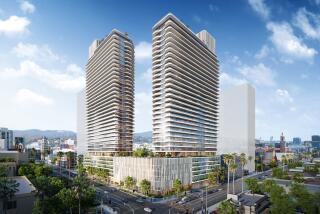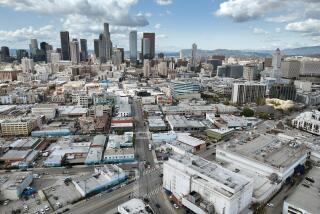$90-million apartment complex to rise near former downtown L.A. cathedral
A $90-million apartment project is underway next to the landmark Spanish-Baroque building that once housed St. Vibiana’s Cathedral in downtown Los Angeles.
Developer Holland Partner Group broke ground this month on an eight-story, 237-unit building with 4,000 square feet of retail. The construction ends a decades-long effort to redevelop the lot near 2nd and Main streets where the Union Rescue Mission once served thousands of homeless men and women.
The cathedral and the nondenominational mission have since moved, and Holland’s project is just the latest development along Main Street. The area has transformed over the last 15 years from a rough stretch widely considered part of skid row into one with upscale restaurants, $2,000-a-month lofts, and bars serving craft beer and cocktails.
In November, the century-old Regent Theater near 5th and Main streets reopened with an attached cocktail bar and gourmet pizza joint. A month later, renowned chef Neal Fraser debuted Redbird in Vibiana — as the desanctified church is now called — which prolific downtown developer Tom Gilmore transformed into an event space in 2005.
“Main Street now has a CrossFit,” said Thomas D. Warren, who oversees Holland’s Southern California operations. “It’s really lively.”
The Holland development — near the Downtown Independent theater — will probably attract those seeking such an atmosphere, Warren said.
Rents for the studios, one-, two- and three-bedroom units are expected to range from $1,500 to $4,000. Residents will be able to enjoy a roof-top deck with a pool and hot tub. Leasing is expected to start late next year.
Hal Bastian, a downtown Los Angeles development consultant, said the project would bring more life to the surrounding neighborhood by filling in an empty spot along northern Main, an area still interspersed with parking lots such as the one Holland’s project is replacing.
“Any time you add bodies it’s a good thing,” he said. “It adds life and adds more people in the street.”
The lot just south of 2nd Street, which Holland purchased last year for $15.75 million, once represented the Main Street of old.
The Union Rescue Mission moved there in 1926, after it was evicted from its previous home to make way for City Hall.
The mission offered food, shelter and a prayer to thousands during its nearly 70 years at the Main site. Over the decades, those it helped shifted from mostly downtrodden elderly men to younger, more troubled men and women.
Drug-ridden encampments lined the sidewalk.
In 1989, the former Community Redevelopment Agency sought to “upgrade” Main and voted to pay the mission $6.5 million to move about five blocks away, into the meanest stretch of skid row. Five years later, the mission opened a $29-million, 225,000-square-foot complex on San Pedro Street.
Critics charged the relocation would further concentrate too many services and homeless people into one area, a concern that continues today as downtown’s upscale remake shifts the homeless population — many who are mentally ill and struggling with addiction — into tighter quarters.
Proposals for the mission’s old home came and went. When it moved, the city’s redevelopment plan called for Plaza St. Vibiana, a pedestrian plaza next to the cathedral with low-rise housing and commercial buildings.
That vision, however, was shaken by the 1994 Northridge earthquake, which severely damaged the 1876 church.
Cardinal Roger Mahony sought to raze the landmark and the Union Rescue Mission buildings for a new cathedral, but sparked a bruising preservation battle instead. Workers felled the mission property in 1995, and the church eventually found another site on Temple Street overlooking the 101 Freeway, where it built the modern Cathedral of Our Lady of the Angels.
In 1999, Gilmore arrived. The developer purchased the abandoned St. Vibiana’s Cathedral and the former rescue mission lot from the Roman Catholic Archdiocese of Los Angeles.
Gilmore has played a key role in the resurgence of the historic downtown core through the rehabilitation of aged properties along Main and Spring streets.
Over several years, he remade the crumbling church into an event space and envisioned a 41-story residential tower rising next to it on a parking lot where the Union Rescue Mission once stood. The high-rise vision, however, was waylaid by the recession. Gilmore received city approval for a smaller project and sold the property to Holland.
Warren said an eight-story building made more economic sense and fits better with the mid-rise neighborhood.
“A high-rise would have really overshadowed” the shell of the former church, he said.
“We are hoping our building provides a nice backdrop to this beautiful cathedral.”
Twitter: @khouriandrew
More to Read
Sign up for Essential California
The most important California stories and recommendations in your inbox every morning.
You may occasionally receive promotional content from the Los Angeles Times.







